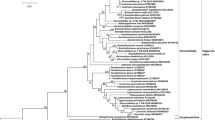Abstract
The amoebocyte-producing organ inLymnaea truncatula is located between the pericardium and the kidney. In control snails bred at 20° C, the organ only has fibroblast-like cells and type I amoebocytes; its growth is associated with a decrease in cellular density. The organ in infected snails bred at 20° C enlarges from day 1 to day 21 after exposure (phase 1) with a rapid increase in the number of type I amoebocytes. Then a gradual cellular rarefaction occurs in this organ from day 21 to day 70 after exposure (phase 2) with a fall in the number of type I amoebocytes and a correlated increase in the number of type II amoebocytes. The connective septae become “fibrous” with thickening from day 42 to day 70 after exposure.
The breeding temperature only affects the timing and the dates when the different developmental phases begin in this organ. At a given temperature, the body volume of the snail affects only the cellular density. The amoebocytic rarefaction in the organ is uninterrupted if the snail begins its fast on day 49 after exposure (phase 2, 20° C); the organ becomes “fibrous” if the fast begins on day 14 after exposure (phase 1, 20° C). The significance of these observations is discussed.
Similar content being viewed by others
References
Cheng TC, Guida VG (1980) Hemocytes ofBulinus truncatus rohlfsi (Mollusca: Gastropoda). J Invertebr Pathol 35:158–167
Kinoti GK (1971) Observations on the infection of bulinid snails withSchistosoma matthaei. II. The mechanism of resistance to infection. Parasitology 62:161–170
Lie KJ, Heyneman D, Yau P (1975) The origin of amebocytes inBiomphalaria glabrata. J Parasitol 63:574–576
Lie KJ, Jeong KH, Heyneman D (1980) Tissue reactions induced bySchistosoma mansoni inBiomphalaria glabrata. Ann Trop Med Parasitol 74:157–166
Loker ES (1979) Pathology and host responses induced bySchistosomatium douthitti in the freshwater snailLymnaea catascopium. J Invertebr Pathol 33:265–273
Ollerenshaw CB (1971) Some observations on the epidemiology of fascioliasis in relation to the timing of molluscicide applications in the control of the disease. Vet Rec 88:152–164
Pan CT (1958) The general and topographic anatomy ofAustralorbis glabratus. Bull Mus Comp Zool Harvard College 119:237–299
Pan CT (1963) Generalized and focal tissue responses in the snail,Australorbis glabratus, infected withSchistosoma mansoni. Ann NY Acad Sci 113:475–485
Pan CT (1965) Studies on the host-parasite relationship betweenSchistosoma mansoni and the snailAustralorbis glabratus. Am J Trop Med Hyg 14:931–976
Rachford FW (1976) Host-parasite relationship ofAngiostrongylus cantonensis inLymnaea palustris. II. Histopathology. Exp Parasitol 39:382–392
Rondelaud D (1974a) L'évolution des rédies deFasciola hepatica L. chezGalba truncatula Müller en Limousin. Revue Méd. Vét 125:237–250
Rondelaud D (1974b) Recherches sur l'influence de quelques facteurs physiques sur les migrations quotidiennes deGalba truncatula Müller. Ann Parasitol Hum Comp 49:417–425
Rondelaud D, Barthe D (1980) Etude descriptive d'une réaction amibocytaire chezLymnaea truncatula Müller infestée parFasciola hepatica L. Z Parasitenkd 61:187–196
Sminia T (1974) Haematopoiesis in the freshwater snailLymnaea stagnalis studied by electron microscopy and autoradiography. Cell Tissue Res 150:443–454
Yousif F, Blähser S, Lämmler G (1980) The cellular responses inMarisa cornuarietis experimentally infected withAngiostrongylus cantonensis. Z Parasitenkd 62:179–190
Author information
Authors and Affiliations
Rights and permissions
About this article
Cite this article
Rondelaud, D., Barthe, D. The development of the amoebocyte-producing organ inLymnaea truncatula Müller infected byFasciola hepatica L. Z. Parasitenkd. 65, 331–341 (1981). https://doi.org/10.1007/BF00926728
Received:
Issue Date:
DOI: https://doi.org/10.1007/BF00926728




